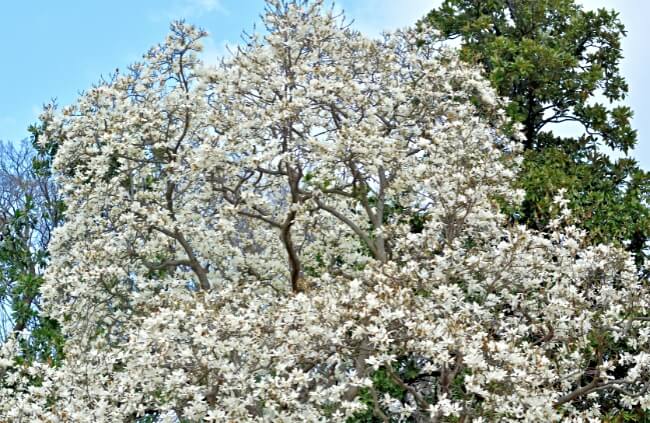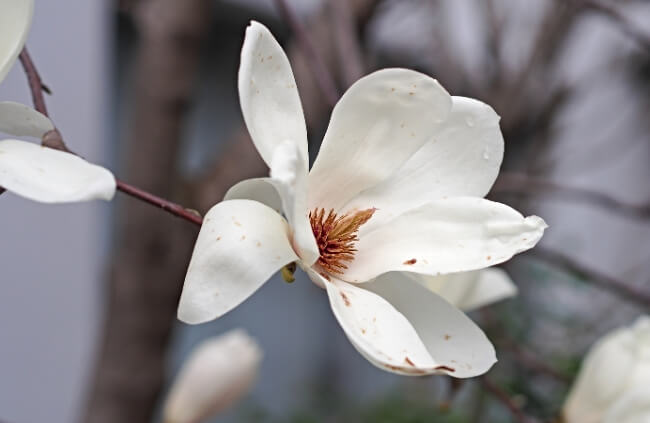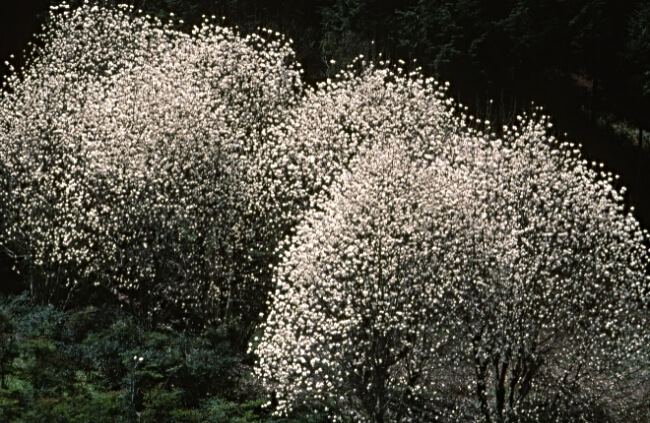Cultivated globally but particularly well-loved in Australian gardens, it is an all-around stunner that is cherished for its deliciously scented ivory-white, goblet-shaped blooms that are borne in large clusters on bare limbs.
In addition, the tree sports beautiful bright green ovate leaves and a gorgeous rounded form once established. There’s really little reason not to consider growing this award-winning species!
In this comprehensive guide, I will explain everything you need to know about growing and caring for the Yulan magnolia in Australian gardens.
More...

Family: | Magnoliaceae |
|---|---|
Genus: | Magnolia |
Species: | M. denudata |
Common Names: | Yulan Magnolia, Lily Tree |
Origin: | Central and Eastern China |
Location: | Outdoor |
Type: | Tree |
Growth: | 8 to 12 metres tall, 3 to 8 metres wide |
Sun requirements: | Full sun to part shade |
Foliage Colour: | Green |
Flower Colour: | White |
Flowering: | Late winter to spring |
Edible Parts: | Edible petals |
Maintenance level: | Low |
Poisonous for pets: | Non-toxic to cats and dogs |
The citrusy fragranced flowers have long been revered as a symbol of purity and nobility, with blooms being worthy as gifts for ancient Chinese emperors. That in itself should speak volumes for the sheer beauty of these delicate white blooms!
The tree itself is a small growing deciduous specimen that is perfectly suited for gardens of all sizes and settings, offering extremely showy floral displays throughout autumn and into spring.

Introducing Yulan Magnolia
Botanically named Magnolia denudata, this tree forms a part of the Magnoliaceae family of plants with lily tree being another very common name for the species. It is actually one of the oldest magnolia species grown today.
Native to central and eastern China, Magnolia denudata is now also widespread throughout Asia, Australia, and other temperate parts of the world.
Considered a slow-growing species, it reaches about 8 to 12 metres tall, and 3 to 8 metres wide when cultivated in gardens. It can be kept smaller in containers but I would recommend rather using a dwarf magnolia, like Magnolia ‘Teddy Bear’, for container gardening.
The tree has a short trunk and can be grown in a single-trunked or multi-trunked form, perfect for many landscaping applications in residential gardens. Its shallow roots are non-invasive so it can also be planted closer to buildings and paving if need be.
Common Uses for Yulan Magnolia
- Feature or specimen tree
- Group plantings
- Border planting
- Canopy tree for shady gardens
- Cottage gardening
- Cut flowers look gorgeous in floral arrangements!
How to Grow Yulan Magnolia
This species is best grown from seed or propagated using cuttings. Seeds can be hard to come by in Australia so many choose to rather purchase young established trees from reputable Australian nurseries, then simply transplant them into their gardens.
If you have a tree, keep an eye out for the exotic fruit and collect ripe seeds in early autumn, sowing as soon as possible while the seeds are still fresh.

Growing Lily Tree from Seed
- Soak your seeds overnight in warm water then remove them the following day, gently rubbing the coating of the seeds off using a cloth
- Seeds need to be kept cool until ready for sowing, you can place them in the fridge in a pot of moist sand while you get them ready
- Prepare containers filled with a quality seed-raising mix then gently sow the seeds into the top 5 cm of soil, lightly watering afterwards
- Place the containers away from direct sunlight in a location that is sheltered and warm with some indirect light
- Water well once the soil dries to the touch until seedlings emerge
- Transplant seedlings into individual pots once they are about 15 cm tall and can handle the move
- Allow them to stay indoors for the first one or two winters before transplanting into the garden in early spring
Propagating Magnolia denudata Using Softwood Cuttings
- Take healthy softwood cuttings from your tree in spring to summer
- Each cutting should be at least 15 cm long with some leaves
- Prepare containers filled with a quality potting soil or similar well-draining mix
- Remove the bottom leaves then dip the cut end of your magnolia cuttings into some rooting hormone
- Gently place them into the soil, ensuring the cuttings are holding firm and upright
- Water well then place the containers in a sheltered location that gets healthy amounts of indirect light
- Allow cuttings to develop for some time to establish healthy roots then you can transplant them into your garden in early spring
Planting and Growing Conditions for Yulan Magnolia
These trees thrive in moist soils and sunny environments! Sounds easy enough for Aussie gardens, right? Here are the ideal growing conditions for Magnolia denudata.
- Soil Conditions - The tree prefers rich, moist, and deep soil that is slightly acidic. While it can tolerate a range of soil types, soil must be well-draining to avoid any fungal issues. A sandy loam soil would work great!
- Sunlight Needs - Full sun to part shade is preferred for ideal growth and prolific flowering. In hotter climates, afternoon shade will be appreciated whereas in cooler areas, full sun would be ideal.
Quick Planting Tips for Lily Tree
In Australia’s warmer climates, deciduous magnolias are best planted while dormant in late autumn to winter. Choose a planting site that is protected from elemental extremes and strong winds as the branches and blooms are delicate.
Caring for Yulan Magnolia
Overall, this is a fuss-free species that is easy to care for in good conditions. However, I have to mention that frosts can pose somewhat of a threat. While the tree and foliage are tolerant to frosts down to about -20°C, the bountiful and beautiful blooms of this tree are unfortunately susceptible to frosts.


Get Your Free Guide:
Master Growing Australian Natives eBook
A Must Have Complete Guide for Every Australian Garden
Get Your Free Guide:
Master Growing Australian Natives eBook
A Must Have Complete Guide for Every Australian Garden

Here are some of the care basics for the lily tree.
- Overwintering - Young trees and saplings grown in colder climates may need to be protected from snow and frost after their budburst in late winter to early spring. A frost cover for trees can work great. Alternatively, if your tree is still in a container, moving it somewhere indoors can go a long way.
- Watering - Trees will need to be watered regularly in their first year. Once established, water every 2 weeks on average but more during hot and dry spells. Magnolias enjoy soil to be slightly moist at all times, but not soggy.
- Fertilising - Fertilise a few times in spring with an organic slow-release fertiliser at the base of the tree. The fertiliser should be high in nitrogen to help boost leaf development, especially during the initial years.
- Mulching - Mulch regularly in spring and summer around the base of the tree using an organic mulch. Young magnolias can benefit greatly from a good regular dressing of mulch.
- Pruning - Little pruning is required with this species once established. Young trees will need to be shaped and pruned to maintain an upright habit and your desired form – single-trunked or multi-trunked. It is best to prune in the middle of summer when the tree is full of leaves. Remove any dead or damaged branches as needed.
Transplanting Tips
I recommend doing any transplanting in late spring when the weather is warmer and the soil has more natural moisture. The roots of this species are delicate and easily damaged, so always gently dig around the tree and try to avoid disturbing the roots as much as you can.
Yulan Magnolia Pests and Diseases
While serious pest and disease issues are rare for this species, there are a few things to look out for. Most of these mild conditions are usually caused by poor conditions – namely too much or too little light, waterlogged soil, or elements pertaining to the surrounding natural environment.
Black Spot
This fungus usually attacks the leaves, creating black spots and patches, sometimes ringed with yellow. It is important to catch this disease early on before it spreads to too many leaves.
Solution: Prune away infected leaves and branches, cleaning your pruning shears between plants. Then, you can treat the tree with an organic fungicide or neem oil spray, continuing this treatment until you see improvement.
Scale Insects
These small pale insects are also prone to attacking foliage. They appear as tiny white to brown, almost translucent spots and bumps on leaf veins.
Solution: Pruning away infected branches is often the easiest way to remove infestation. Alternatively, you can treat it with a horticultural oil, insecticidal soap, or organic neem oil.
Read our comprehensive guide on how to get rid of scale insects for more details.
Yellow Spot
Yellow spot is a very common disease that affects ornamental plants worldwide. As suggested, it causes intense yellow spotting on both the upper and lower leaf surfaces. In most early cases, it can be treated without any permanent damage to the tree.
Solution: A broad-spectrum fungicide can help stop the spread of the infection. You can also prune away the infected parts of the tree and dispose of them off-site.
Snails
Snails rarely pose a problem for this species, but they can become a nuisance in certain areas.
Yulan Magnolia Frequently Asked Questions

How big do Yulan magnolia trees get?
Magnolia denudata usually grows at a slow rate to around 8 to 12 metres tall and wide as a multi-stemmed tree. As a single-trunked tree, it will grow narrower to about 3 to 8 metres wide.
What does the Yulan magnolia symbolise?
The elegant flowers of this prized magnolia tree have long been a symbol of purity and nobility for Buddhist monks and ancient emperors throughout China.
What is the other name for the Yulan magnolia tree?
The tree is botanically labelled Magnolia denudata, with its most common name being the Yulan magnolia, and its other being the lily tree.
What is the best fertiliser for Yulan magnolia?
A controlled-release organic fertiliser or well-rotted manure can work great. Feed your tree 2 to 3 times in spring to boost leaf development and encourage prolific flowering.
Are any magnolias native to Australia?
Magnolia grandiflora, also known as the bull bay or southern magnolia, is a spectacular species native to the coastal regions of New South Wales and Queensland.
Where do magnolias grow best in Australia?
Deciduous magnolias thrive in a chilly, moist winter followed by a warmer, moist summer. They tend to prefer the south-easterly parts of Australia but can grow in any area that has generous rainfall and cool winters to encourage dormancy.
Interested in learning more about growing majestic magnolias? Be sure to check out our comprehensive guide on the best Magnolia varieties to grow in Australia.
Take Your Gardens Ornamental Beauty to New Heights with Yulan Magnolia
It's easy to enjoy this spectacular tree. It sports the most beautiful blooms in its genus, further elevated by its attractive rounded form and dense glossy foliage. If you need an ornamental tree with showy floral displays, I think this species may be the perfect pick for you.
Whether planted as a feature in cottage-style gardens or planted in groups along borders, the Yulan magnolia won’t disappoint!
Published on January 19, 2025 by Gary Clarke
Last Updated on September 20, 2025




